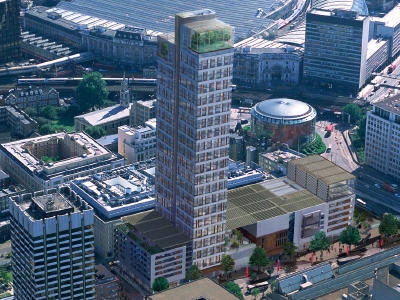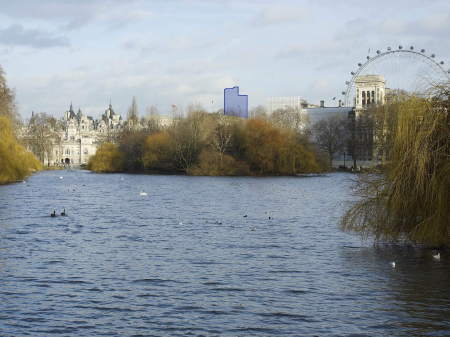Doon Street Tower public inquiry draws to a close
The public inquiry into proposals for a 44-storey residential tower and leisure centre on the South Bank heard closing submissions on Friday at Lambeth Town Hall.


Communities secretary Hazel Blears will now make the final decision on the proposal by Coin Street Community Builders (CSCB) to construct a leisure centre with swimming pool part-funded by the sale of 329 private apartments in a 44-storey tower between Doon Street and Upper Ground on the South Bank.
The minister will receive a report and recommendation from planning inspector Philip Wilson who has heard three weeks of evidence from supporters and opponents of the scheme.
Royal Parks Agency
Solicitor Brian Greenwood, for the Royal Parks Agency, told the inquiry of the "very real harm and damage that the Doon [Street] Tower will cause to views from St James's Park".
He went on to accuse Coin Street Community Builders of making an "extraordinary assumption" that the tower will not cause harm to the protected view from the bridge in St James's Park: "The applicant's failure or refusal even to recognise the patent reality of the potential effect of this development must leave one to question the integrity of their case in terms of this aspect of the development proposal."
Mr Greenwood rejected the suggestion that his client wished to obstruct development at Doon Street: "One only has to see the stance adopted by Royal Parks in the context of the London Eye to understand that the Royal Parks are not pursuing a policy of no development at any cost but simply a policy of no development in the particular location as currently proposed by the applicants.
"It is the undisturbed tree line that must be protected – other development proposals that may affect the existing built skyline will of course be considered by Royal Parks on their merits, as has always been the case, the Shard and the London Eye being but two acceptable examples."
He concluded: "...it is case for Royal Parks that a proposal to construct a tall tower in a location that will so clearly damage the protected views from the grade I listed St James's Park is patently contrary to policy and that the severity of the damage that would be causes is alone sufficient for the proposal to be rejected."
English Heritage
"The development would cause irreparable harm to historic assets of the highest importance," said Neil King QC for English Heritage.
The government's heritage watchdog has focussed its opposition to the tower on its impact on views from St James's Park and Somerset House.
He continued: "English Heritage considers that the community element proposed as part of the development could not justify the grant of planning permission in the face of the harm it would cause."
Mr King said that criticisms of English Heritage made by Val Shawcross AM and Cllr Paul McGlone were "misplaced".
"The scheme, on CSCB's own evidence, appears to be unviable," he said.
"The community benefits on the basis of which planning permission is sought are unlikely to materialise; yet the grant of permission would set a damaging precedent."
Calling for an assessment to be made of the heights and locations where tall buildings could be built in Waterloo without damaging the setting of Somerset House, Mr King said: "If its effect is to constrain the development of tall buildings on the South Bank, then so be it."
Mr King concluded: "If permission is granted and the tower is built, then irreparable harm will be caused to the setting and therefore to the worth of some of London's, and the nation's, most important heritage assets. That would be deeply regrettable, particularly in circumstances where alternative development options for the site have not been fully explored."
Lambeth Council and the Greater London Authority
Eian Caws, for Lambeth Council and the Greater London Authority, argued that the absence of affordable housing from CSCB's proposals is entirely consistent with planning policy.
Mr Caws also said that the development's impact on Somerset House would be neutral, rather than highly damaging as English Heritage contends.
He also accused English Heritage of seeking a blanket ban on tall buildings in Waterloo rather than considering this proposal on its own merits.
Coin Street Community Builders
William Hicks QC, for the applicant, argued that the current proposal provided the best prospect of meeting all the objectives set out for the Doon Street site.
"The reality is that if the height of the tower has to be reduced so as not be visible from the upper terrace of the courtyard of Somerset House or the bridge in St James's Park, then it is most unlikely that the development plan objectives for this site and the leisure centre in particular can be achieved."
He added: "If the proposal is found to be unacceptable a complete rethink will be required, probably involving a further development plan stage, and inevitably significant delay. There would be no leisure centre, no Rambert, and a significant setback for regeneration."
Mr Hicks also rejected English Heritage's contentions about the tower's impact on Somerset House.
"The fact that the proposal, a well-designed modern building, is visible at a distance from some parts of the quadrangle and may remind some people that Somerset House is set at the heart of a modern site does not we believe cause any harm to the setting of the listed building."
He went on to argue against English Heritage's "unjustified and inappropriate" suggestion that as a matter of principle no building should be visible over southern range of Somerset House from any part of the quadrangle: "A requirement that no buildings be visible from the upper terrace would require buildings at Waterloo to be of a significantly reduced order of height, whatever their merits."
In his conclusion Mr Hicks explained that the South Bank is "an opportunity area of strategic importance".
"A key objective for this area is regeneration based on mixed use. The proposal will make a major contribution to that regeneration. Not just physical regeneration but a combination of physical, social, health, economic and psychological.
"The way in which this proposal has been brought forward entirely reflect the Government's desire for more local initiatives."
He added: "A single slender tower of the height proposed is the right design solution for the site, the design of the proposal is of high quality, and it will enhance the South Bank and views of the South Bank. We believe that it will be much admired if planning permission is granted."
Arguing that the "very substantial planning and design benefits of the proposals" outweighed any possible harm, Mr Hicks concluded with a stark warning.
"The secretary of state should be in no doubt that the refusal of this application would be a major setback for the regeneration of this area."
Comments
Share
The SE1 website is supported by people like you
More to read
- Channel 4 to make reality TV show in South Bank Tower penthouse 9 Nov 2022
- Lambeth paves the way for skyscraper on Waterloo IMAX site 8 Oct 2018
- Artist and activist Veronica Planton remembered at Waterloo exhibition 6 Jul 2014
- Queen opens Rambert dance company HQ on the South Bank 21 Mar 2014
- SE1 joins 'prime' central London property market 15 Oct 2013
- South Bank Tower: council approves 5 extra floors and collects £5m 17 Jul 2013
- Shell Centre redevelopment approved: nearly 900 South Bank homes 22 May 2013
- Rambert's dancers get preview of new South Bank headquarters 21 May 2013
- Lambeth kids visit Rambert Dance Company's new South Bank home 6 Mar 2013
- MBE for Coin Street boss Iain Tuckett in New Year honours list 29 Dec 2012
Related forum discussions
- "Mama Mia: The Party" coming to Coin Street?
- Elephant and Castle Leisure Centre Project Consultation
- Blackfriars Road skyscrapers
- Mayoral Election.
- Coin Street's revised plans for a tower of only 43 storeys - still a betrayal of their founding principles?
- New development on Recall site
- London Park Hotel Site
- Swimming lessons for young children
Follow us
Email newsletter
For the latest local news and events direct to your inbox every Monday, you need our weekly email newsletter SE1 Direct.

